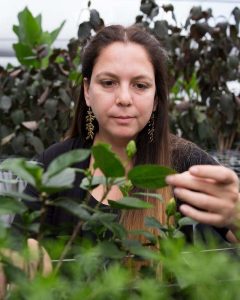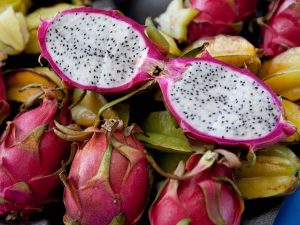
Dragon fruit is a heart-healthy superfood, low in calories and fueled with plenty of fiber and antioxidants – and it’s in high demand among consumers worldwide.
An increasing number of consumers are growing this fruiting cactus vine in their home gardens and are finding new ways to include it as a key ingredient to main dishes, in desserts and drinks. Meanwhile, manufacturers use it for toothpastes, soaps, candles and more. The global dragon fruit market is forecast to grow exponentially.
“Dragon fruit is grown on about 721 acres in five Florida counties, including Palm Beach, Charlotte, Brevard, Lee and most prominently, in Miami-Dade,” said Jonathan Crane, a tropical fruit crop specialist at UF/IFAS Tropical Research and Education Center (TREC). “We see new plantings continue to go in, so the acreage appears to be expanding.”
While some people say it tastes like a cross between a pear and a kiwi, consumers are incorporating it in a variety of ways beyond slicing and eating the fruit as-is. They blend it into smoothies, incorporate it into desserts, add it to yogurt as a topping and even include it in salads.
Despite its popularity, there is a lack of critical information on high-performance varieties, effective cultivation practices, robust pest and disease management programs and fruit quality standards, say UF/IFAS researchers. Meanwhile, other states are seeing a rise in their markets.

“Dragon fruit is increasing in popularity worldwide due to its high versatility, refreshing taste and unique beauty,” said Romina Gazis, an associate professor of plant pathology and director of the Plant Diagnostic Clinic at TREC. “In South Florida, this crop is highly productive, however, it faces multiple challenges that make its cultivation one that requires high inputs.”
Dragon fruit, a widely cultivated neotropical cactus, is a popular crop in California, Florida, Hawaii, Puerto Rico and Texas. It is also gaining traction among urban gardeners in Arizona, Georgia, Louisiana and Oregon. The fruit is known for its high demand and market prices, rapid growth, young bearing age, high yield, long lifespan and water-efficiency, added Gazis.
“By strategically targeting these challenges, including the management of pest and diseases, researchers can provide growers with cost-effective options that will make them more competitive, said Gazis.
UF/IFAS researchers, faculty and agents hosted a three-day workshop at UF/IFAS Extension Miami-Dade County in Homestead to address these gaps and identify challenges and opportunities to grow the U.S. dragon fruit industry.

Held during the peak of harvest season, the program featured farm visits and in-field demonstrations, providing invaluable insights. A working group was formed with core partners from collaborating states to synthesize information learned and from researchers’ interactions with the industry.
“During this workgroup meeting, we narrowed down the research and Extension priorities to develop a roadmap for future steps,” said Gazis.
The program attracted more than 80 participants from across the country to South Florida, where the fruit thrives in both home landscapes and in small to medium-sized farms. The event brought together growers, handlers, experts in horticulture, plant health and economics, along with representatives from academia and the industry.
One takeaway from the workshop was the potential to build an ancillary industry to transform dragon fruit pulp into value-added products. This could provide a solution for fruit not destined for fresh consumption and utilize fruit of less aesthetic value.
The workshop was a key step in a $50,000 grant awarded to TREC in 2023 by the U.S. Department of Agriculture National Institute of Food and Agriculture (USDA-NIFA) as part of the Specialty Crop Research Initiative. The objective is to identify research and Extension priorities that will help develop a multistate proposal.
The grant project has reached a pivotal point now that input from consumers, dragon fruit producers and distributors have been collected during the current dragon fruit harvest season, which lasts through November.
As the project moves into the next reporting period, the research team will focus on synthesizing data collected. Researchers are currently analyzing survey and interview responses, expecting to release a publication in December.
“The event was a significant step toward assisting and expanding the dragon fruit industry and related value chains, promising exciting developments in the future,” said Crane. “The information from the consumer survey and this workshop will be invaluable in identifying industry needs and research grants to assist in the development of the U.S. dragon fruit industry.”
The brainstorming session, which gathered representatives from several sectors of the industry, including producers, government and researchers, was critical for identifying research and Extension priorities, said Gazis. “This information, will help us develop strong proposals that will generate science-based solutions and support a growing industry.”
###
By Lourdes Mederos, rodriguezl@ufl.edu
Para accesar a este contenido en español, por favor utilice el siguiente enlace.
ABOUT UF/IFAS
The mission of the University of Florida Institute of Food and Agricultural Sciences (UF/IFAS) is to develop knowledge relevant to agricultural, human and natural resources and to make that knowledge available to sustain and enhance the quality of human life. With more than a dozen research facilities, 67 county Extension offices, and award-winning students and faculty in the UF College of Agricultural and Life Sciences, UF/IFAS brings science-based solutions to the state’s agricultural and natural resources industries, and all Florida residents.
WHY FOOD IS OUR MIDDLE NAME
Feeding a hungry world takes effort. Nearly everything we do comes back to food: from growing it and getting it to consumers, to conserving natural resources and supporting agricultural efforts. Explore all the reasons why at ifas.ufl.edu/food or follow #FoodIsOurMiddleName.
 1
1
